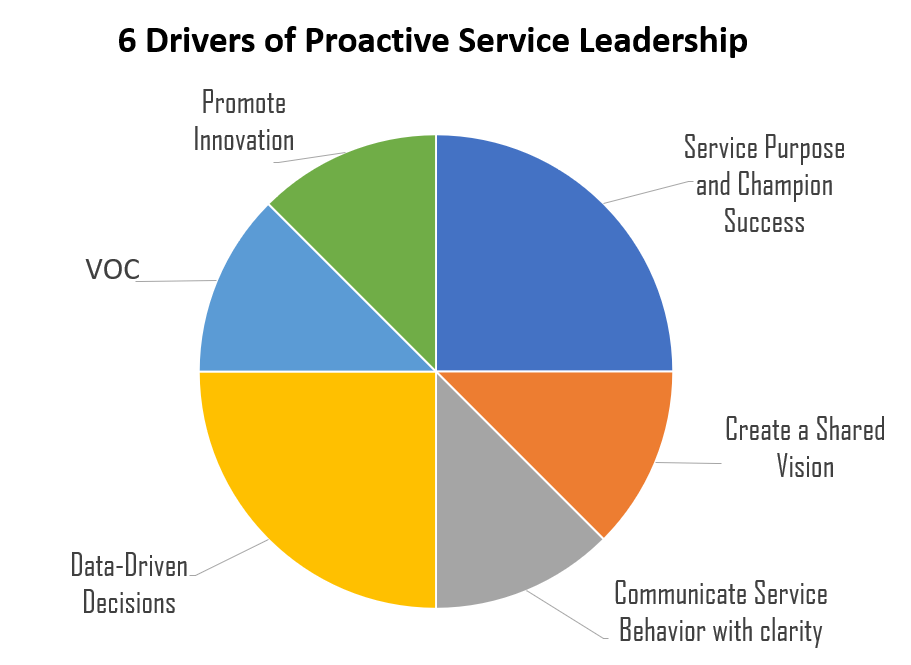Proactive Service Leaders
“The highest type of ruler is one of whose existence the people are barely aware of. Next comes one whom they love and praise. Next comes one whom they fear. Next comes one whom they despise and defy” – Lao-Tzu
Value and Value Drivers are changing. In service, if any Organization desire to innovate products and services that create values for customers, then Leaders in those organizations need to understand what the Drives Value to their customers…. not from their perspective but their customer’s point of view! By doing this, companies can provide better customer experience driven by leaders and are called superior service organizations.

The traditional definition of service generally limits it to work done by one person or group for the benefit of a significant community or to satisfy a specific need for a particular individual. In such a context service includes the organizational reflection-in and reflection-on clientele plus persistent effort that one undertakes to improve the totalitarian ability to satisfy the needs of others efficiently, proactively and ethically.
Proactive service leaders in superior service organizations recognize that service-chain is so delicate and it impacts:
• Organizational Performance
• Market Positioning
• Client Acquisition and brand attraction
• Competitive advantage and sustainability
• Repeated customers rates
• Products & Pricing Positioning
• Values delivered by organizations
The Leader-first and the Service-first are two extreme types. Between them, some shadings and blends are part of the infinite variety of human nature.”
The diversity reveals itself in the responsibility considered by the Service-first to make sure that other people’s most essential priority requirements are fulfilled.
Throughout my experience and working with many international organizations, I found that superior service organizations had one thing in common; Proactive Service Leadership!
The superior service organizations have Leaders who are aware of the importance of service in all aspects of the business framework internal, external. And they play an instrumental role in architecting service value chain and align the employees around unified service purpose through a proactive approach which makes the service a culture rather than a fluctuating responsive trend.
In superior service organizations such as Google, Mercedes, MacDonalds, and many others, Leaders has a strong ability to identify the importance of proactive service alignment within the business framework. Those organizations hire leaders who can innovate in service and spread the service culture across the organization and in the community they serve. Those leaders perform a proactive service alignment within their business framework. They act more as service catalyst and less as traditional managers. This is mainly performed through innovative service solution along with empowering, motivating and inspiring the employees to create positively engaging customer experience throughout the business touchpoints. I also noticed that those leaders know for a fact that customers could tell when the organizations are focusing on providing great experience and when it is not.
The Proactive Service Leader is a ready, willing and able, on-the-spot socialized entrepreneur who possesses relevant task competencies and is judged by superiors, peers, subordinates, and followers to exhibit appropriate character strengths and a caring social disposition.”
In business, the Proactive Service Leader is capable of making a brave decision to enhance the internal process and create a better customer’s value. He/she can align people under one vision and make sure they are motivated, capable and enabled to perform their job.
“Leadership is any service aimed at ethically satisfying the needs of self, others, groups, communities, systems, and environments.” – Po Chung 2011
According to Robert Greenleaf, the author of the Servant Leadership book in 1973, the most common thing is the ability to distinguish between dictatorial, participative and unrestrictive leadership styles. The authoritarian style of leadership requires clearly defined tasks and monitoring for accomplishment and results. The decision-making duty rests with the executive.
In contrast to the autocratic, the practice of a participative and proactive leadership style involves employees in the decision-making. This dynamic style means delegation for more extensive tasks to employees and placing them in the driver’s seat to perform a crucial and fundamental role in influencing the customer buying decisions and increases the client lifetime value and their share of wallet. Also, this means the increase in the employees’ responsibility in retaining customers. Leaders in the superior service organizations, as a result, are aware of the importance of creating service purpose and the importance of empowering employees to make the right customers’ decisions.
“Service leadership is about satisfying needs by consistently providing quality personal service to everyone one comes into contact with, including one’s self, others, groups, communities, systems, and environments.
Superior service organizations know that with the increasing market demands and market disruptions, the customers have more options to explore, more products and services to choose from! And they understand that they are moving up on escalator that is always moving down!

After years of observation and thorough analysis of these superior organizations, and after looking at each angle of what those service leaders do, six drivers are being concluded.
The six drivers of Proactive Service Leaders are as follows:
- Create Service Purpose & Champion Success Stories
- Create a Shared Vision
- Data-Driven Decisions
- Promote Voice of Customers (V.O.C)
- Communicate Service Behavior with clarity
- Promote Innovation
Author
Mahmoud Iskandarani
CEO & Managing Partner
